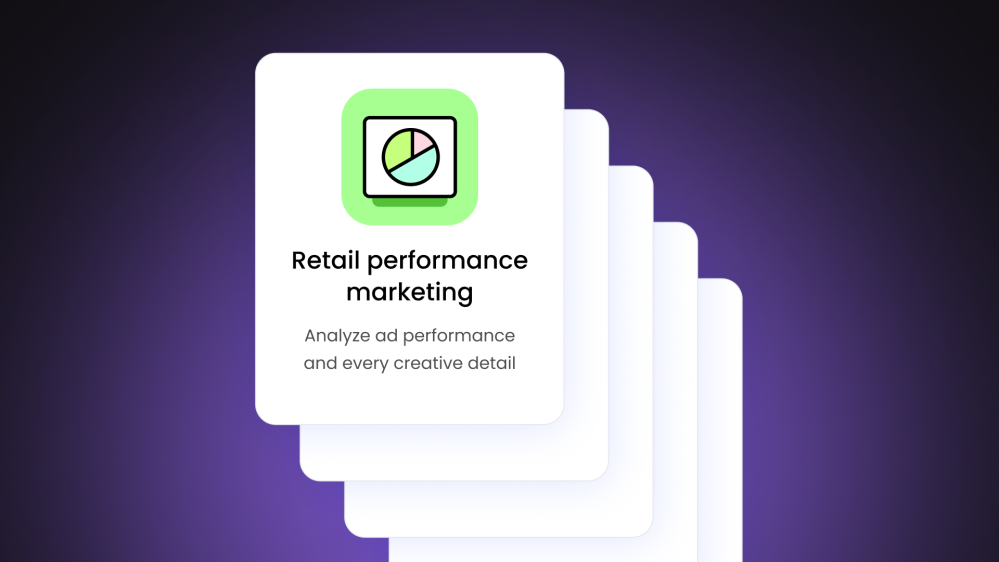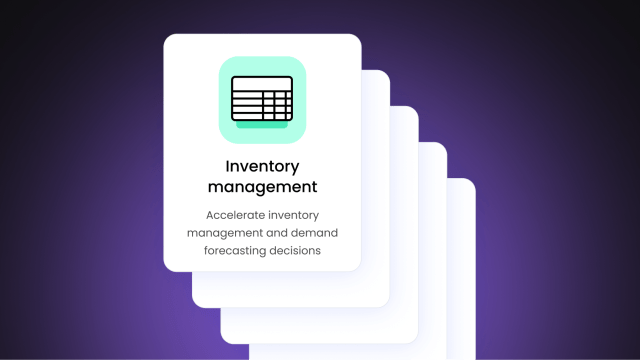AI agents at work
– 14 min read
Stop debating your creative. Start decoding it.

I sat in budget meetings for years where we bet millions on “winning” ads without ever truly knowing why they worked. This is how AI agents are finally decoding creative performance, and what it means for your ability to turn ad spend into a predictable growth engine.
- Performance marketers struggle to understand why a creative is successful because performance data doesn’t connect to the creative elements within the ad itself.
- The traditional process of post-campaign creative analysis is a slow, manual, and inefficient cycle that yields vague insights and guarantees wasted ad spend.
- Existing technology, like BI tools and in-platform analytics, operate in silos and are unable to bridge the gap between unstructured creative content and structured performance data.
- AI agents solve this by systematically analyzing creative assets at scale, turning subjective elements like imagery and copy into an objective, structured, and analyzable dataset.
- This new approach elevates marketers from data wranglers to strategic thinkers, enabling them to make precise, data-driven decisions that directly improve ROAS and lower CPA.
I’ll never forget the budget meetings at Adore Me. We’d have a single “winning” creative on a slide, one that beat the return on ad spend (ROAS) target, and the room would nod. But that “win” always felt hollow. It was a snapshot, not a story. We couldn’t definitively say why it won. Was it the model’s pose? The headline? The specific shade of blue in the background? We were celebrating a conclusion without understanding the premise.
The daily reality for performance marketers is that they must make their next creative bet for their upcoming advertising campaigns based on an incomplete story. The link between the elements of an ad, the performance marketing channels it runs on, the bidding strategies that support it, and the revenue it generates is a black box.
For too long, we’ve accepted this gap as a cost of doing business. But a new approach, powered by agentic AI, is finally building the “connective tissue” between creative decisions and key business objectives like revenue. It’s about moving beyond celebrating the lone “winner” and instead building a factory for producing them at scale.
Why your performance marketing workflow is leaking money (and how to fix it)
As performance marketers, we live in a world of precision and control. We master bidding strategies, obsess over cost per acquisition (CPA) targets, and navigate the walled gardens of social media platforms with tactical expertise. In a world where advertisers pay marketing companies based on clicks or conversions, the pressure to understand what drives those conversions has never been higher. But this relentless focus on downstream metrics often obscures a more fundamental and costly problem — we’re optimizing what we can measure, not necessarily what matters most to our overall performance marketing strategy.
I’ve seen the same painful, fragmented process of creative analysis play out in countless marketing organizations. It’s a cycle of wasted effort that I call the “cross-channel campaign post-mortem,” and it looks something like this.
The ask comes down from leadership, “Our latest cross-channel campaign just ended. We need to understand the creative drivers of customer acquisition to inform next quarter’s digital marketing strategy.”
Week 1: The data silo scramble
An analyst begins the hunt, pulling performance data from Google Ads, Meta, and TikTok — key channels for social media advertising. A media buyer exports spreadsheets detailing bidding and spend. A brand manager digs up the creative assets from a DAM. From the very first step, the data doesn’t connect. Each platform’s attribution model tells a conflicting story, making it impossible to form a single source of truth.
Week 2: The spreadsheet nightmare
The analyst, now armed with a dozen CSVs, attempts to merge the datasets in a monstrous Excel file. They spend days wrestling with inconsistent UTM parameters and trying to map performance marketing campaigns across platforms. The brand manager, meanwhile, resorts to manually tagging hundreds of creatives with subjective labels like “aspirational” or “product-focused.” No one can definitively link a specific creative element to a downstream conversion because the last-click attribution model inevitably gives all the credit to a generic brand search engine marketing ad. It completely ignores the complex customer journey influenced by other channels or even initial discovery through search engine optimization.
Week 3: The inconclusive debrief
After weeks of manual labor, the team presents its findings. The conclusion is almost always disappointingly vague — “Video seems to be working well on TikTok.” This insight, while technically true, offers no real direction for the creative team and, crucially, no actionable intelligence for the media buyer on how to adjust bidding strategies for specific creative types. The cycle of inefficiency is guaranteed to continue, directly impacting your overall marketing ROI.
At this point, many leaders I speak with ask a fair question: “Can’t my BI tool or my creative platform already solve this?” It’s a question I’ve asked myself. But the answer is no. They’re each missing a critical piece of the puzzle.
Why can’t my current tech stack connect creative performance to cost per acquisition?
That question gets to the heart of the problem. Our existing tools are powerful, but they were built for a different era of analysis. They operate in silos, and as a result, none of them can see the full picture on their own.
Here’s why:
- BI tools (Tableau, Looker): These are powerful for visualizing existing, structured data. They can create a perfect chart showing you that an ad performed well, but they’re unaware of the unstructured content within the ad. They can’t analyze the image, the copy, or the call to action. They can show you the result, but they can’t tell you the reason.
- Creative optimization platforms (e.g., VidMob): These tools are excellent for analyzing and improving creative, but they often operate as a separate point solution. They provide valuable creative scores and recommendations, but don’t always integrate deeply with your full suite of data from all performance marketing channels — the bidding strategies, the spend allocation, and the final business objectives. They analyze the creative in a vacuum.
- In-platform analytics (Meta, Google): While essential for channel-specific data, they’re walled gardens by design. They are optimized to report on performance within their own ecosystem and can’t provide a holistic, cross-platform view of your marketing efforts. They will never be able to correlate creative elements with performance across your entire marketing mix.
So if your existing stack looks at data in silos, how do you build the connective tissue needed to find the real answers? This requires a fundamentally new approach that doesn’t just visualize data, but creates a new, proprietary dataset from your creative itself.
AI agents are built for the modern era of analysis. They’re not another dashboard. An agent acts as the connective tissue between all these systems, ingesting data from each to create a single, unified view of creative performance.
How AI agents perform ad creative analysis at scale
When I describe this new approach, the skepticism is palpable. “So, it’s just a faster BI tool or a more complex dashboard?” It’s a natural reaction, but it misses the fundamental shift. An AI agent for retail performance marketing doesn’t just visualize data faster. It does something entirely new. It has the unique ability to translate unstructured pixels and copy into structured, actionable patterns.
This is what that looks like in practice:
- Ask your data anything instantly. The old workflow involves filing a ticket with the data team and waiting days for a custom report. An agent changes that dynamic completely. A brand manager can now ask a complex, multi-layered question in plain English: “Show me all video ads under 15 seconds that feature a person smiling and rank them by hook rate.” The agent understands the query, writes the code to analyze the unstructured video content, cross-references it with performance data from your ad platforms and third-party tracking platforms, and returns a clear, ranked answer in minutes.
- From subjective tags to objective attributes. The agent replaces the slow, inconsistent, and biased process of manual tagging with objective analysis at scale. It can look at an image and identify the dominant color palette. It can watch a video and measure the exact screen time a logo gets down to the millisecond. It can transcribe the audio, analyze the sentiment of the copy, and identify every object in the scene. It systematically turns the unstructured chaos of your creative assets into a structured, analyzable dataset.
- Uncover non-obvious correlations. Because the agent can analyze every creative element against every performance metric, it can surface patterns a human analyst would never have the time or capacity to find. For example, it might generate a testable hypothesis like: “For our European target audience, creatives with a price point shown in a rounded font (e.g., €10) have a 5% higher click-through rate than those with a sharp-edged font.” This is exactly the type of concrete, data-backed ideas that provide a clear, testable path for the next creative sprint.
This ability to deconstruct creative and connect it to performance isn’t just theoretical. Let’s look at one of the most powerful performance marketing examples I’ve seen with a fast-growing beauty brand.
How one brand used AI to find a $1M insight in their retail performance marketing data
I was on a call with the VP of growth at a fast-growing beauty company just a few months ago. They were prepping for their biggest sales event of the year and were about to commit a seven-figure budget based on the top-performing ad from their last major advertising campaign. It was a polished, expensive-looking studio shot that had, on the surface, delivered the best ROAS. But he had the same feeling I used to have in those budget meetings at Adore Me — a nagging doubt that the story behind the numbers was more complex than the spreadsheet showed.
His ask was simple and direct, “Before we go all-in, can you pressure test this? Tell us why that ad worked and if there are other hidden patterns we’re missing across the thousands of ads we ran last year.”
The flaw in their “best” ad
The team was right that their polished studio ad was a winner, but they were wrong about when and why. The agent broke down the ad’s performance by the hour and discovered its impressive overall ROAS was a misleading average. In reality, the ad was an average performer during the day, but became a 7x ROAS superstar in a very specific window — 10pm to 2am.
The agent correlated this with social media platform data and found that this was the time block when over 80% of their audience was browsing on a tablet or desktop computer, not a phone. The ad’s rich, high-resolution, and detailed visuals were largely wasted on small mobile screens during the day. But on a larger screen late at night, when users were in a more relaxed, lean-back browsing mode, the ad’s cinematic quality created an immersive, high-end experience that drove consideration and trust.
The team was about to scale the ad’s creative style across their entire budget, assuming it worked everywhere. The agent proved the real, scalable insight was about matching creative fidelity to the user’s device and mindset. This completely changed their holiday strategy. They reallocated their budget to run their expensive, cinematic ads specifically to desktop and tablet users in the evening, while deploying simpler, bolder, mobile-first creative during the day, saving them from scaling the right ad in the wrong context.
The impact of finding an insight like this goes beyond a single campaign. It fundamentally changes the day-to-day work and strategic value of the marketing team itself.

Want to see exactly how an agent delivers this kind of report?
See the WRITER Performance Marketing Agent in action
Will AI redefine the roles of modern performance marketers?
During a recent pilot, after the agent produced an analysis in an hour that would have taken his team two weeks, a director of performance marketing didn’t look worried. He looked relieved. He turned to his lead analyst and said, “So, your job is no longer about being the fastest person in the company at VLOOKUPs. Your new job is to take these insights and tell us the story. What should we test next?”
That conversation perfectly captures the evolution of the performance marketer in the age of AI. It’s not about replacing people — it’s about elevating their roles from tactical execution to strategic leadership.
- The analyst becomes an “insights translator.” Instead of spending their days cleaning data and wrestling with spreadsheets, they use the rich creative performance data to challenge simplistic attribution models. They can finally show the true, nuanced value of top-of-funnel creative and tell a compelling story about what’s really driving customer acquisition.
- The media buyer becomes a “portfolio manager.” Armed with creative-level insights, they can move beyond platform-level bidding strategies. They can now confidently and precisely bid up on campaigns that target specific audiences who are proven to respond to a certain creative format or message, maximizing the efficiency and impact of every dollar spent.
- The creative strategist finally gets a direct, quantitative feedback loop. Data replaces the guesswork. They can see exactly which elements resonate and why, allowing them to build a data-driven creative playbook and scale it across the entire organization.
AI agents remove the friction — the manual data pulls, the endless spreadsheets, the inconclusive debates — that prevents that expertise from being used effectively. It allows your performance marketers to finally track performance in a meaningful way and truly perform.
Connecting your creative strategy to measurable results
For years, we’ve accepted a certain level of ambiguity in our work. Relying on top-level metrics and gut feel to guide a multi-million-dollar creative strategy is no longer a viable option for growth. The speed of the market and the complexity of the digital landscape demand a more rigorous, data-driven approach to achieve measurable results.
Agentic AI provides that missing analytical layer. It’s the connective tissue that finally links the DNA of your creative — the pixels, the copy, the concepts — to the real-time performance metrics that define success. This fundamental shift empowers your team to move from a slow, reactive cycle of post-mortem analysis to a fast, proactive engine of creative testing, learning, and scaling.
WRITER’s enterprise-ready creative engine
WRITER’s performance marketing agents are this creative engine for your organization, making the principles discussed in this post an operational reality.
Our agents have a core set of capabilities that directly address the challenges of modern creative analysis. They can:
- Analyze thousands of your creative assets — images, videos, and copy — at a scale no human team could ever match, using sophisticated computer vision and natural language processing
- Autonomously connect the specific attributes within that creative to hard performance metrics from all your paid advertising channels, including social media platforms and search engines
- Surface statistically significant patterns and generate clear, testable hypotheses about which creative elements are truly driving campaign performance, moving your team beyond correlation to causation
What sets WRITER apart
This isn’t another point solution that creates more dashboards and new data silos. WRITER provides an end-to-end platform that integrates directly and securely into your existing marketing ecosystem.
- Smooth, read-only integration: Connect directly to your ad platforms and creative asset libraries without disrupting your existing workflows.
- Enterprise-grade governance: Our platform has the security controls and data governance that enterprises require.
- A flexible, scalable platform: Grow with a system that can handle everything from a single-campaign analysis to monitoring your entire global creative portfolio.
The proven benefits for performance teams are tangible and immediate:
- Higher ROAS and lower CPA through rapid, data-driven optimization
- Increased media spend efficiency by eliminating waste on underperforming creative
- Faster learning cycles and a more agile, resilient creative digital marketing strategy
The future of retail performance marketing won’t be defined by who has the most data, but by who can extract actionable intelligence from it the fastest. It’s time to turn your creative from a line item into a growth engine.
Ready to see what’s really driving your campaign performance?
The difference between theory and results is seeing it with your own data. You can see real examples of how retailers are using WRITER’s performance marketing agents to turn creative insights into their most valuable growth lever to drive sales and improve customer retention.
But the most powerful proof comes from your own campaigns.
Let’s start with a focused pilot. Instead of a generic demo, let’s answer the one critical question about your creative that you’ve never been able to solve. All we need is read-only access to your ad accounts and your creative library. In a few days, we’ll show you the creative elements tied to your most important key performance indicators.




